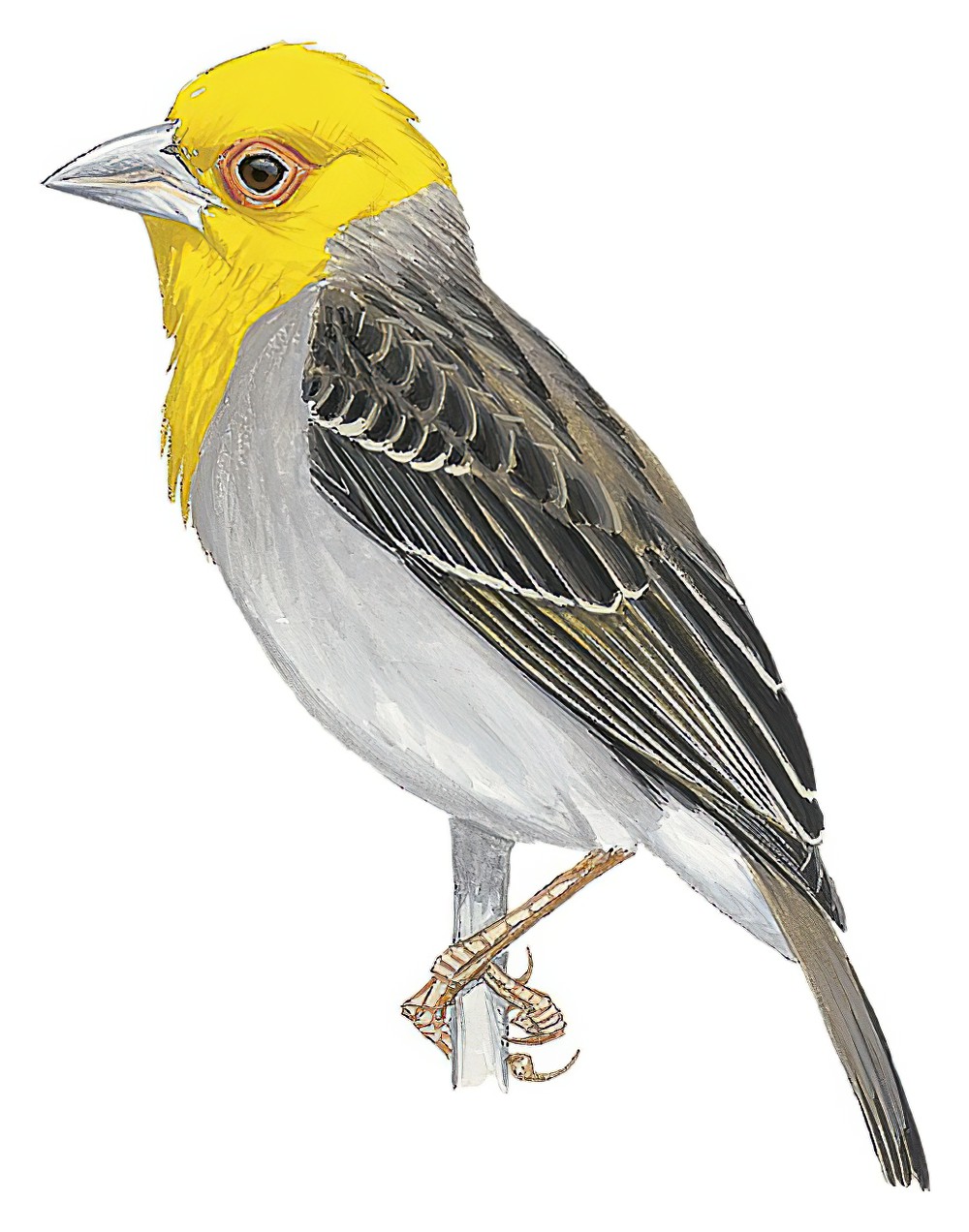Sakalava Weaver / Ploceus sakalava

Sakalava Weaver
SCI Name:
Protonym: Ploceus sakalava Orn.Madagascar p.54
Taxonomy: Passeriformes / Ploceidae / Ploceus
Taxonomy Code: sakwea1
Type Locality: Madagascar.
Author: Hartlaub
Publish Year: 1861
IUCN Status: Least Concern
DEFINITIONS
PLOCEUS
(Ploceidae; Ϯ Baya Weaver P. philippinus) Gr. πλοκευς plokeus weaver < πλεκω plekō to plait, to entwine; "LES TISSERINS. (PLOCEUS. Cuv.) (2). A bec assez grand pour les avoir fait en partie classer parmi les cassiques; mais sa commissure droite les en distingue. Ils ont de plus la mandibule supérieure légèrement bombée. On en trouve dans les deux continens. La plupart de ceux de l'ancien font leur nid avec beaucoup d'art, en entrelaçant des brins d'herbes, ce qui les a fait nommer TISSERINS. Tel est le Toucnam-Courvi des Philippines. (Loxia Philippina. Lin.) Enl. 135. Jaune tacheté de brun, à gorge noire. Son nid, suspendu, est en forme de boule, avec un canal vertical, et ouvert en dessous, qui communique par le côté dans la cavité où sont les petits (1). Quelques-uns rapprochent leurs nids en grande quantité, pour en former un seule masse à plusieurs compartimens. Tel est le Républicain. (Loxia socia. Lath.) Paterson. Voy. pl. 19. ... (2) Πλοκευς, tisserand. ... (1) Ajoutez le capmore, Buff. (Oriolus textor, Gm.), enl. 375 et 376. — Fringilla erythrocephala, enl. 665. — Le prétendu tangara de malimbe, Daud. An. Mus. I, p. 148, pl. x. — Le baglafecht. (Lox. Abyssinica.) — Le nélicourvi (lox. pensilis), Sonn., 2e Voy. pl. 109." (Cuvier 1817); "Ploceus Cuvier, 1817, Règne Anim., 1, p. 383. Type, by subsequent designation, Loxia philippina Linnaeus (Gray, 1840, List Gen. Birds, p. 42)." (Moreau in Peters 1962, XV, 32). Recent work indicates that the African and Malagasy members of this genus should be included in Malimbus.
Var. Ploceys.
Synon. Bensonhyphantes, Cinnamopteryx, Deignaniplectes, Deleplectes, Dendrhyphantes, Eremiphantes, Eremiplectes, Euploceus, Eupodes, Heterhyphantes, Hypermegethes, Hyphantornis, Hyphanturgus, Hypositagra, Icteropsis, Melanhyphantes, Melanoploceus, Melanopteryx, Microplectes, Microploceus, Nelicurvius, Notiospiza, Oriolinops, Oriolinus, Othyphantes, Pachyphantes, Phormoplectes, Plesiositagra, Ploceella, Ploceolus, Rhinoploceus, Saka, Sharpia, Sitagra, Sitagroides, Sycobrotus, Symplectes, Textor, Thomasophantes, Xanthophilus, Xanthoplectes, Xanthoploceus.
sakalava
Sakalava, an indigenous clan of Madagascar.
SUBSPECIES
Sakalava Weaver (sakalava)
SCI Name: Ploceus sakalava sakalava
sakalava
Sakalava, an indigenous clan of Madagascar.
Sakalava Weaver (minor)
SCI Name: Ploceus sakalava minor
minor
L. minor smaller < comp. parvus small. “Comparative names ... Specific names expressive of comparative size are also to be avoided, as they may be rendered inaccurate by the after-discovery of additional species. The names ... maximus, minor, minimus, etc. are examples of this objectionable practice” (Strickland Code 1842).
● ex “Short-eared Owl” of Pennant 1761 (syn. Asio flammeus).
● ex “Little Thrush” of Catesby 1731-1743, Edwards 1758-1764, Latham 1783, and Pennant 1785, “Turdus iliacus carolinensis” of Brisson 1760, and “Grivette de l’Amérique” of de Buffon 1770-1783 (syn. Catharus fuscescens).
● ex “Whip-poor-will” of Catesby 1731 (Chordeiles).
● ex “Coucou des palétuviers de Cayenne” of d’Aubenton 1765-1781, pl. 813, “Petit Vieillard” of de Buffon 1770-1783, and “Mangrove Cuckow” of Latham 1782 (Coccyzus).
● "54. PICUS. ... minor. 12. P. albo nigroque varius vertice rubro, ano albido. Picus albo nigroque varius, rectricibus tribus lateralibus seminigris. Fn. svec. 83. Hasselqv. iter. 242. Picus varius tertius. Raj. av. 43. Picus varius minor. Alb. av. I. p. 20. t. 20. Habitat in Europa.” (Linnaeus 1758) (Dryobates).
● ex “Fregata minor” of Brisson 1760, “Petite Frégate” of de Buffon 1770-1783, “Man of War Bird” of Edwards 1760, and “Lesser Frigate Pelican” of Latham 1785 (Fregata).
● ex “Petit Indicateur” of Levaillant 1807, pl. 242 (Indicator).
● ex “Pie-grièsche d’Italie” of d’Aubenton 1765-1781, pl. 32, fig. 1 (Lanius).
● ex “Perruche à ailes noires” of de Buffon 1770-1783, “Petite perruche de l’isle de Luçon, 4ème ésp.” of Sonnerat 1776, and “Luzonian Parrakeet” of Latham 1781 (syn. Loriculus philippensis).
● ex “Apiaster Philippensis minor” of Brisson 1760 (syn. Merops viridis americanus).
● ex “Little Woodcock” of Pennant 1785, and Latham 1785 (Microptera).
● ex “Troupiale de la Caroline” of d’Aubenton 1765-1781, pl. 606, fig. 1, “Petit Troupiale noir” of de Buffon 1770-1783, and “Lesser black Oriole” of Latham 1782 (syn. Molothrus ater).
● ex “Lesser Bird of Paradise” of Latham 1783 (Paradisaea).
● ex “Barbican à ventre rose” of Levaillant 1806 (Pogonornis).
● ex “Porphyrio minor” of Brisson 1760 (syn. Porphyrula martinica).
● ex “Colymbus fluviatilis” of Brisson 1760 (syn. Tachybaptus ruficollis).
● ex “Huppe d’Afrique” of Audebert & Vieillot 1800-1802 (syn. Upupa africana).
● ex “Ringvia” of Brünnich 1764, and “Lesser Guillemot” of Pennant 1785 (syn. Uria aalge).
UPPERCASE: current genus
Uppercase first letter: generic synonym
● and ● See: generic homonyms
lowercase: species and subspecies
●: early names, variants, mispellings
‡: extinct
†: type species
Gr.: ancient Greek
L.: Latin
<: derived from
syn: synonym of
/: separates historical and modern geographic names
ex: based on
TL: type locality
OD: original diagnosis (genus) or original description (species)












